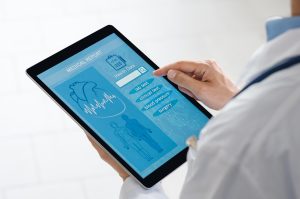
Introduction to EHR – What are the Benefits of Electronic Health Records?
Table of Contents
An electronic health record or EHR is today’s modern take on the paper patient charts of the past. While many healthcare organizations still use paper charting, there are countless advantages to the digital transformation of EHR. That said, to best serve patients and providers alike, EHR must be implemented safely and effectively.
What is EHR?
While the simple explanation is that EHR is the digital version of a paper chart, a lot more goes into EHR. EHRs collect and reflect medical history and treatment history with notes from practitioners but can also include a lot of other data. An EHR implemented and used correctly can give a very broad view of a patient’s overall health and care.
Like most paper health records, an EHR includes medical history, including diagnoses, medications, and treatments, as well as future plans, immunizations, allergies, diagnostic imaging, and test results. EHRs are updated in real-time, meaning any time there is a change to a patient’s health or something worth noting, the EHR reflects it with input from other systems. And, perhaps one of the biggest draws of EHR, any authorized provider can share and use the record.
For example, if a patient is referred to a specialist, that specialist can access the same EHR the family doctor uses. There are not two systems in place, with data siloed, but instead, one central location for all relevant information. EHRs, thanks to their digital format, can be shared with labs, emergency facilities, workplace clinics, pharmacies, and any other relevant and approved party involved with patient care.
EHR vs EMR, PHR and MPM – what’s the difference?
There are many acronyms in healthcare! EHR (electronic health record), EMR (electronic medical records), PHR (personal health records), and MPM (medical practice management software). Here’s how to tell the difference.
EMR – Electronic Medical Records
We’ve covered what EHR is, of course. EMR sounds like it will be something similar, but there is a slight — and important — difference. Electronic medical records came first and were largely used for medical purposes by clinicians diagnosing and treating patients.
EHR switches medical for health, for a reason. While ‘medical’ is a term relating to medicine, health is a lot more holistic, referring to the overall wellbeing of mind and body. EHRs are thus more comprehensive than EMRs.
When you think about a traditional paper chart held in a doctor’s office, that is closer to what an EMR is. EMRs are strictly the digitized version of those office charts, covering the medical and treatment history of patients in one practice. EMRs are not shared across practices and practitioners like an EHR can be, but they have their role within individual practices.
PHR – Personal Health Records
A personal health record or PHR is something that can be controlled by a patient. While EHRs are controlled by practitioners, PHRs are more of a self-management item for patients who want to keep track of their own medical data. The two can be linked or stand-alone.
MPM – Medical Practice Management Software
Finally, medical practice management software is used by practices to handle the backend of business. While an EHR handles patient data, MPM is for things like patient scheduling and billing, e-prescriptions, financial reporting, and other aspects of administrative data and information.
Types of EHR systems
While all EHR systems have similar capabilities and functionalities, different types of EHR platforms exist. Healthcare practices can choose between different configurations, which have their own advantages and disadvantages.
Physician-hosted systems put responsibility for the EHR in the hands of the physician or practice. Patient data is kept on servers held within the practice location, and the physician/practice is responsible for buying the hardware and software. They also have to maintain the system and ensure the security and integrity of the data.
The advantages of a system like this are largely based around speed, as there is little delay with the server on site. The challenges come down to the cost of owning and operating the system, and the personal responsibility for maintenance and security.
Then, there are remote systems, which are operated by a third party. There are three types of such systems:
- subsidized
The most common scenario here is a subsidized system when a physician is using an EHR system hosted by a hospital, which controls the data and maintenance of the system. For a smaller practice that cannot manage the cost or workload of an on-site system, this can be a good option. However, practitioners should fully understand how much control they will have over the EHR and ensure they are comfortable with the legalities and ownership of data.
- dedicated
There are also dedicated remote systems, through which a practice stores EHRs on a vendor service. The vendor is responsible for the data and its storage, which gives physicians less control, but fewer IT concerns.
- cloud-based
Finally, there are cloud-based EHR systems. A vendor runs these systems, which means a physician does not need to manage or maintain the system. The information is readily accessible from any device with internet access, yet kept secure by the vendor. As with other remote systems, the disadvantages focus around lack of control over the information, and advantages include ease of use and lower costs.
Core Functions and Features of EHR Systems
As outlined above, there are different approaches to how an EHR is implemented, but all share key functions and features. If you are looking for an EHR system, or building one yourself, make sure these are included.
All EHR systems need to store, process, and organize data so that medical practitioners and professionals can access that information. Ease of use is critical, as this is the information required to properly treat every patient.
Results management is thus a core function, ensuring professionals that work in different settings can access lab and test results the moment they are available, in real-time. Conversely, they can share results with others, including the patients, for better patient care and engagement.
Order management is another core feature, ensuring that any requisitions for tests or prescriptions are streamlined. With all orders entered into one database, there are fewer chances for error. Using a digital platform improves legibility as well as speed.

EHR systems need to ensure flawless communication and connectivity with other providers who are using the EHR. They also need to provide patients with information, and ideally, allow patients to communicate with the practitioner or practice in some way.
Consequently, EHRs should enable remote monitoring for patients with chronic conditions. Patient support should also extend to the ability of giving patients access to their health records and additional education resources.
Thanks to some built-in practice management features, healthcare providers can improve efficiency. With use of reporting tools and by automating some tasks, you can streamline a lot of administrative processes. Workflows, for example, show how patients move through the system to enhance the practice (i.e., ensuring there is a patient in each prepared examination room rather than waiting). Some EHR systems include patient scheduling, with automated reminders through a patient portal. Others offer templates, which allow practices to pre-build charts that will be regularly used.
Even better, some integrate data analytics, creating reports that improve healthcare for patients and providers alike. And, they should provide practitioners with decision support, using medical history and data to help guide treatment plans.
There are various features within EHR systems that physicians and other users may want. To find the ideal EHR system, practitioners and healthcare organizations need to think about the way they work and what could be improved. Whether it’s self-serve patient portals, automated decision support, or order sets, there are EHR features that can solve almost every problem.
Benefits and Challenges of EHR Systems
Any time an industry can move away from error-prone, redundant, insecure paper records, it is a benefit! EHRs create organized records, with few concerns about legibility, storage footprints, or accessibility. Digital transformation is designed to make life easier and more streamlined, and EHRs are a great example of this.
The other big benefit of EHRs is practice improvement. At the point of care, practitioners have accurate, up-to-date, complete information about patients without having to go hunting for it. They can search for specific information and readily coordinate care with others who are involved. This means more effective diagnosis, reduced medical errors, and safer, faster care.
With practice improvement patients are more satisfied with the care they receive, and patient/provider communication and engagement is also improved. Providers have better work-life balance, with automated and streamlined systems that reduce the amount of time needed to properly care for patients. Costs are reduced with less paperwork, better safety, fewer needless duplications, and overall improved health.

There are also challenges that come with EHR, much like any other system. For example, when an EHR is not user-friendly, it can contribute to feelings of burnout as it represents another need for time-consuming data entry. Some EHRs can also cost a lot of money, challenging for small practices especially.
With any healthcare system, regulatory compliance, privacy, and confidentiality will be a challenge and a concern as well. It’s important to work with a vendor that understands state and federal regulations with which practitioners must comply. For example, an electronic signature in the form of a typed-out name, common in many EHR platforms, won’t meet compliance for Medicare. It’s also important to work with a vendor that understands critical privacy and confidentiality of patient data.
Finally, interoperability is a big concern when choosing an EHR. That refers to the ability of different systems, including EHRs, to connect and coordinate across organizational boundaries.
The concept of a well-working EHR hinges on the ability to safely and efficiently share patient information between other EHRs and healthcare providers. If systems are not interoperable, a new bottleneck forms and a lot of the advantages of EHR fall apart.
Any EHR system one uses or develops needs to promote interoperability, meeting standards that ensure data sharing can happen across clinics, labs, hospitals, and pharmacies. Regardless of the technology, or the specific vendor, interoperability is a must-have to harness the power of EHRs.
Overview of Electronic Health Records
To show how all of this works in real life, we will highlight a few popular EHR systems on the market today.
Epic
Epic holds a large market share when it comes to hospital EHR systems, and is a cloud-based solution. It offers core EHR functionalities as well as modules for specific specialties, with a focus on patient engagement and facilitating remote care. The patient portal is a very popular feature, with mobile apps and access to telehealth options.
When it comes to interoperability, Epic is well-known as a leader. The company even offers an open API to facilitate integration with third party software and apps.
Cerner
Cerner is another major EHR system, offering a platform called Millennium. This EHR is another platform that is highly focused on interoperability, cooperating well with third party apps and systems. For example, when a practitioner inputs a prescription in the EHR, they can then link with a pharmacy in the area that meets the patient’s needs.
Cerner is proof of EHRs working well on a large scale. In 2015 the company was awarded a contract with the US Department of Defense, replacing its legacy IT health system in hospitals, clinics, and military locations.
These are two of the largest EHR vendors on the market, but practitioners are not limited to any specific vendor. What is most important is ensuring that the system meets both practice and patient needs, and all regulatory and compliance challenges.
Working with our Team
We are here to help you build a health tech product that delivers value to your own customers, meeting their needs. We understand how health tech can positively influence patient outcomes and administrative management, and have firsthand experience carrying out digitization projects. We are all about helping organizations find efficiency, while promoting ease of use and accessibility of users who deserve a friendly solution.
We create fast and secure solutions that are committed to the principles of interoperability. We are certain we can give your staff the data they need, with one click. Let us know what we can do for you — fill in a project estimate today, and our team will work with you to create something that makes your practice better.
You can also get in touch by emailing success@concisesoftware.com. We look forward to working with you!
This may interest you:
Telehealth – Your Ticket to On-Demand Healthcare Services
4 benefits of Internet of Things for healthcare
The Rising Popularity of Apps for Mental Health
Virtual Reality in Healthcare – Transforming Medical Education and Patient Care
Artificial Intelligence in Healthcare: Key Trend in Digital Transformation
Big Data in Healthcare – Unlocking the Potential of Medical Records
Predictive Analytics in Healthcare – Staying One Step Ahead of Emergency
HIPAA guidelines for healthcare apps development
Your Guide to the Benefits of Telemedicine Apps
Wearable Devices: Embracing Technology for Better Patient Care
Why should we worry about healthtech? Facts and thoughts
Major medtech trends to follow in 2022 and beyond!
What are the risks in digital healthcare?
Safe and user-friendly apps: improving the quality of healthcare
How Software Development is Driving Innovation in the Healthcare Industry